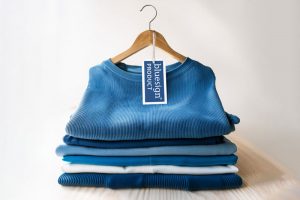
TW Special Report
With sustainability now the primary driver in all consumer product markets, SGS — a testing, inspection and certification company — examines the demand for sustainable fashion and the importance of certifications like the bluesign® PRODUCT label for combating greenwashing.
In the global fashion industry, projections indicate that the sustainable segment is expected to grow steadily over the next few years, with a 1.4 percentage point increase between 2023 and 2026.1 This growth is partially driven by younger generations who define themselves as environmentally conscious and are reaching economic maturity.
Barriers to sustainability
Choosing a product that is truly sustainable can be a challenge for consumers. Markets are flooded with products that claim environmental credentials, but how many of these claims can be trusted?
In a 2022 survey of US consumers, 54% stated they found it confusing to identify which fashion items were environmentally friendly, with only 5% strongly disagreeing and saying they felt it was easy.2 Part of the difficulty is that many consumer product markets are now blighted by ‘greenwashing’, defined by the European Union as, “the practice of giving a false impression of the environmental impact or benefits of a product, which can mislead consumers.”3
The proliferation of claims and labels can make it challenging for the eco-conscious consumer to find a product that genuinely meets their requirements. What they need is reliable certification, provided by a trusted and independent verifier, that confirms a product meets clearly defined standards for sustainability.
bluesign® PRODUCT
The bluesign PRODUCT label provides consumers with assurance that the product they buy adheres to the highest safety standards, meets minimum requirements for environmental and human impact, and is made using responsibly sourced materials. This label can be applied to:
- Clothing, including denimwear;
- Home textiles, excluding carpets and textile wall coverings;
- Equipment – tents, luggage, etc.; and
- Footwear, excluding brown shoes.
Certification is achieved following a rigorous assessment of the product and its supply chain, evaluating factors such as energy, water and chemical consumption, CO2 emissions and waste generation. Supply chain impact data for these parameters is collected from brands, materials manufacturers and chemical suppliers, providing a clear overview of the environmental performance of the inputs, facility and product.
The criteria for bluesign® PRODUCT certification are complex, building confidence in the assessment process and label. Certified apparel must meet the following requirements:
- Possess a textile character;
- At least 90 percent of the fabric used in the apparel must be bluesign APPROVED;
- At least 30 percent of the accessories used in the apparel must be bluesign APPROVED (rising to 40 percent from 2027);
- All components (fabrics or accessories) not bluesign APPROVED must be supplied by a qualified supplier and must meet the brand’s restricted substances list (RSL); and
- If an additional claim is applicable for the certified apparel (e.g. organic cotton), third-party certification must be available.
In addition, there are specific requirements for denim manufacturers regarding the use of indigo dyes, laundry practices and sandblasting. To be certified as a bluesign® PRODUCT, denim products must meet the following criteria:
- Outer fabric must be at least 90 percent denim;
- 100 percent of the denim fabric must be bluesign APPROVED;
- 90 percent of textiles must be bluesign APPROVED (rising to 40 percent from 2027);
- All components (fabrics or accessories) not bluesign APPROVED must be supplied by a qualified supplier and must meet the brand’s restricted substances list (RSL);
- Prohibited practices include chlorine bleaching, pumice stonewashing, sandblasting, and the use of potassium permanganate (PP) and powder-based enzymes;
- If an additional claim is applicable for the certified apparel (e.g. organic cotton), third-party certification must be available
In the case of footwear, alongside the requirements for additional claims and non bluesign APPROVED components, certification demands that 90 percent (by area) of skin contact materials (textile upper, lining and insole), midsole and outsole, and at least 30 percent of total accessories, must be bluesign APPROVED.
Consumer Benefits
Purchasing a bluesign PRODUCT provides consumers with assurance that the product meets exacting standards for environmental impact reduction and better working conditions in the supply chain. It guarantees transparency and trustworthiness in an era when greenwashing is a significant issue.
Consumers can easily identify the bluesign PRODUCT label, which can be found as a hangtag, sewn-in label or printed on the garment and/or packaging. They can also shop for bluesign PRODUCTs via the bluesign SHOP.
SGS & bluesign
SGS joined forces with bluesign in 2008 to develop its services and strengthen the independent bluesign SYSTEM solution. From fiber to finished product, bluesign partners with brands, manufacturers and chemical suppliers to promote safer workplaces and textile products that are less impactful on the environment and people.
References:
1 Global: sustainable apparel revenue share 2013-2026 | Statista
2 Confusion over sustainability of clothes U.S. 2022 | Statista
3 Stopping greenwashing: how the EU regulates green claims | Topics | European Parliament (europa.eu)
October 15, 2024




